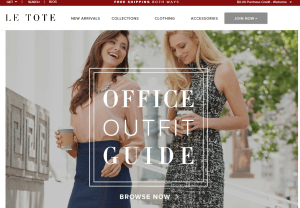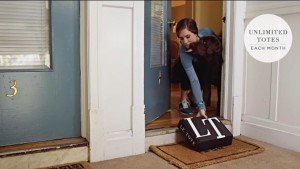Le Tote – “Netflix for clothing”
Overview
Le Tote is a subscription-based fashion rental startup for clothing and accessories. It was established in 2012 by Rakesh Tondon and Brett Northart and raised total #27.5 million worth of funding in three rounds as of November 2015. Le Tote’s business model is ‘Netflix for clothing’ – the customer pay $49 monthly fee and receive three garments and two accessories at home.


Business Model
“I have a huge closet with full of clothes but nothing to wear!” This is the most common complain that we hear around all the time. The average woman spends $1,700 on clothes annually and U.S. apparel industry is a $12 billion business. Le Tote is ‘Netflix for clothing’ – the customer pay $49 monthly fee and receive three garments and two accessories at home. Now the customer doesn’t have to go shopping or even no need to explore thousands of online website anymore to find your personal style. The customer can send back at any time to receive new items if he/she doesn’t like the item they received.
But why does online fashion rental service work? Why are people using Netflix or AirBnB – like model (subscription model) even in a fashion industry? Here are three reasons why it works.
Why Le Tote?
- A frequent use of social network service – People spend more time than any time before using SNS (Social Network Service) such as twitter, facebook, Instagram. People add pictures about daily life experiences or un-tag ugly picture from friend’s wall on facebook. The social media created the need for this sharing economy – we want to experience different life – from house, car, and now to clothes (just as Uber, Airbnb). In the midst of innovation in technology, change in paradigm, our wardrobe is still the most outdated place in our house (compared to kitchen or living room).
- A fast-changing consumer behavior into ‘sharing economy’ – As a result of two combination – economic recession and digital innovation, the consumers, especially a young generation who has seen a lowest economic growth ever, experiences a fast shifts into the new shopping behavior. Major users of ‘Sharing Economy’ e-commerce, such as Uber, Rent the Runway, are young people. It’s just not that they don’t have enough economic power, but that they’re more open-minded to this new paradigm.
- Development in Technology and Logistics – a development of logistic technology is a one of key aspect to success of the business. It takes often 1-2 day to receive the packages (including new subscription box and refreshed box). All the delivery fees are included in monthly fee.
- Accessible Pricing – Psychologically $49 of month fee is reasonable price for anyone. This price range can capture a wide range of consumer from someone looking for fast-fashion brand to someone interested in trying variety of brands.
Simple operating process of Le Tote:
- The customer sign up and fill out the initial survey. The survey is used to analyze the preferred style of the customer.
- Le Tote will prepare next style profile to send to this customer based on the survey and algorithm on the data base of system.
- The customer receives the package with 3 garments and 2 accessories every month – there are two options: the customer can receive Le Tote’s selection or choose own selection.
- The customer holds any items they want to purchase and pack everything else in the pre-paid envelope.
Operating Model
Risk
- Competitor – It is a still early stage for fashion startup industry and especially a number of competitors are trying to figure out their way to survive in online subscription commerce industry. Rent the Runway, Trunk Clun, Stitch Fix, Gwynnie Bee, The Ms.Collection, JustFab are the competitors providing online fashion rental services. Rent the Runway, which is the biggest player in the industry, recently announced the new service ‘ Rent the Runway Unlimited’. The company originally focused on renting special occasion dress but now they expanded the business into the area where Le Tote dominated.
- High churn rate – This is one of the biggest problem with Le Tote is facing. The consumer can try couple times for curiosity, but if they are not satisfied with the service for some reason (e.i. late delivery, missing item, or laziness to send back the items they don’t like), easily stop the subscription service.
Conclusion
More than any time before, now people more care about “experiences” than “owning a thing”. We are all in our own personal-brand business – we create our personal image, which is a ‘mock version’ of ourselves. We want to see, hear, and try more variety of experiences. I believe an e-commerce fashion industry in digital space has a huge potential to grow, which is untapped territory compared to other crowded e-commerce space. I think an emperor of e-commerce in fashion industry will appear in the next few years and rule out the online and offline space. Le Tote just started its journey; as a first mover, it will see more opportunity.
Sources
http://fortune.com/2015/11/19/le-tote-15-million-funding/
http://www.wutail.com/le-totes-does-renting-work/
http://www.forbes.com/sites/emmajohnson/2015/01/15/the-real-cost-of-your-shopping-habits/





Is there any views on how the business is actually doing? Any publicly shared figures around the size of customer base and the ability of the company to retain them?
Very interesting business model and I would love to know more about their operating model. Does the company own the inventory or it collaborates with third party retailers? How many SKUs are made available to end consumers? Logistics sound extremely complex – how are monthly delivery and returns managed? Is it possible to actually purchase rented items?
Regarding the business model, I would be very interested in knowing whether there are different price points depending on whether customers select specific items rather than just a style and if there are “premium” subscription fees for higher end items.
Thanks for sharing!
Very interesting retail model, thanks for sharing! I had heard the name but didn’t know much about Le Tote itself. I would presume that getting a rental to convert into a purchase is how Le Tote makes the most of their money, but how does Le Tote do that? Do they look at similar shoppers to gauge their purchase patterns? For the customers that choose a package with Le Tote’s selection, is an actual stylist involved in the selection (or is it only algorithm-based)? I would be curious how they maximize their hit/purchase rate per customer. This ability to supply shoppers actual items that they love is also critical to minimizing their churn rate.
I also presume that the success of Le Tote relies on being on top of the fashion trends. How does Le Tote partner with wholesalers to get the newest product, or can they? Suppose that a BB Dakota dress just hit Bloomingdale’s and Nordstrom’s, as well as the BB Dakota website itself. This item is full-price. I would be skeptical if BB Dakota or other wholesalers would be willing to sell this new product to Le Tote, given that this item can be purchased from Le Tote’s website at a discount. Does Le Tote only receive items once they have been in regular distribution channels for a given time frame? If so, as Le Tote grows, can they look to develop exclusive product from their wholesalers as a new competitive edge? I worry customers might get upset if it becomes clear that they are getting “late” product (if that is the case).
Really interesting post! I hadn’t heard of this company before. It seems like Le Tote’s biggest differentiator is that you can have Le Tote choose what it sends you. Seems more akin to a Birchbox for clothes in that sense than a Netflix for clothes. I’m wondering how popular that option is, given style and fit can vary so much across customers. A personal stylist would require a lot of manpower that the company probably won’t be able to scale, but an algorithm could increase the churn rate since it likely can’t be as precise with fit or potential style as a human could. If a customer receives clothing that doesn’t fit/they don’t like two months in a row due to the algorithm being too broadly implemented, for example, they would be less likely to continue to subscribe.
I am actually in my first month of my Le Tote subscription after 2-3 months of toying with the idea of subscribing to one of these clothing rental businesses. I think they have a number of operational challenges. First of all, the product (rentable closet) is only as good as its size and variety. Therefore they require a massive base of customers in order to support the inventory they must hold. However, they are also dependent on customers referring their friends to grow. Yet I’m not sure how many women want to be seen worn the same thing their friend just wore a couple of weeks ago. Secondly, the quality of the experience is also dependent on the speed of their service. Currently, it takes at least 2 days to return a tote and another day for them to “style” and then 2-3 more days for the new tote to be sent out. In essence, while they promise unlimited totes, a customer can realistically maybe get 2 totes per month. While this might help reduce their costs and meet demand, it may cause dissatisfaction from customers. I would suggest they offer different tiers of service and speed in order to capture the full value of their service. Overall, while it is an interesting concept, I think there are still operational kinks and customer messaging they need to work out.